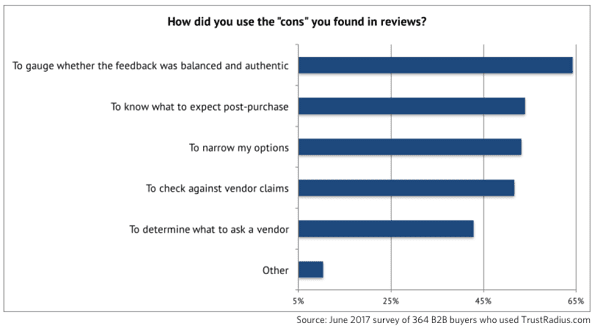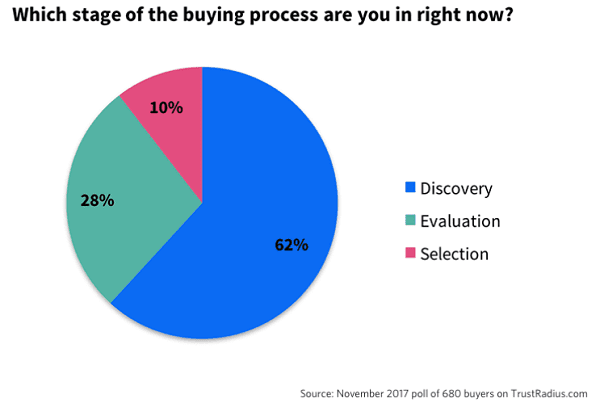Think about the last item you purchased a product or service. Then consider why you chose that specific option. Nine times out of ten, you were influenced by the review or advisement of someone who had experience with the product.
According to study conducted by TrustRadius, 76 percent of respondents who were in an active buying cycle used reviews to help them evaluate, discover, or select items.
People care about what other people think regarding products or services. Why? Because they feel they are getting an unbiased opinion from fellow customers.
This is why it is essential for companies to include customer reviews in their marketing strategy. Not only will reviews provide tangible marketing benefits, but you can also see improvements to the bottom line with this strategy in hand.
Seven Ways To Encourage Customer Reviews
According to this survey, a one-star increase on Yelp leads to a five-to-nine percent increase in business revenue. The positives are there, so here are seven ways companies can encourage customer reviews within their overall marketing strategy.
-
Ask Them
This may seem like too straightforward of an approach, but it can go a long way. Companies can send follow-up emails after customers receive a product or service, asking them to enter their testimonials or feedback.
Email marketing tools, such as MailChimp and SendGrid, can help automate this process. With automation, you can collect reviews at scale.
-
Make Existing Reviews Easy for Sales Reps to Access
Ensure that your sales representatives and staff know exactly where they can grab the best testimonials to use with prospective clients. Always label your testimonials according to type of review and associated product.
With the proper organization, your internal teams will be able to easily use them in email correspondence, phone calls with prospects, and demo training. You can even go so far as to make these statements a part of your company culture.
-
Use Negative Reviews to Showcase Customer Service
Direct your marketing teams to spend time visiting sites like Yelp or Google, in order to thank customers when your business receives positive reviews.
When your company gets a negative customer review, don’t be too concerned or apprehensive about it. Use it as an opportunity — this is an excellent time to showcase customer service.
Marketers can directly respond to negative reviews and even give customers a number or email to call to receive better service. According to TrustRadius, 65 percent of customers look for negative reviews to see how companies manage feedback.
If you handle it properly, it can actually work to your advantage down the road.


-
Incorporate Reviews into Webpage Copy and Marketing Collateral
Once you collect a number of reviews, be sure to include reviews in as many places as possible. You can use them in blog posts, web copy, brochures, landing pages, email newsletters, etc.
You’ll even be able to benefit the company by pointing out the ways you’re improving on negative reviews and comments over time.
-
Use it to increase SEO rankings
SEO practices help companies organically rank their websites high on search engines like Google and Bing.
SEO requires marketers to intelligently mix in keywords throughout the webpage copy and blog posts to rank for various keywords.
Your website stands to benefit from ranking on a wider range of keywords if you decide to weave in customer reviews on website copy.
In this way, reviews can stand to help you generate ongoing copy additions without having to craft entirely new web pages or blog posts on a daily basis.
-
Reach Customers in the Discovery Process
In the poll referenced earlier, 62 percent of “shoppers” were early stage buyers in the discovery phase.
Customers use this phase to find out as much as they can about a product.


You can help potential customers move forward through the discovery process by providing current product descriptions with reviews available for each item.
Think like the customers, and you’ll better be able to present them with the right information to consider when they are searching for an item that fits their needs.
-
Include Comparison Reviews
Comparison reviews, i.e. those that compare competitive products to your own offerings, can be massively beneficial to winning over new customers.
These types of reviews can draw a picture that explicitly details how the products differ from one another. And that, very often, will give you a leg up on the competition.
By showing how customers hold your product(s) in high regard, you will position yourself very strongly in the eyes of prospects and customers.
Conclusion
People want to feel they can trust companies. The voice of an unbiased customer is a huge benefit to you in earning that trust with new prospects.
By employing this strategy, you will enjoy an improved reputation and a high level of authenticity among your target audiences.
What’s more, it has become much easier to collect customer reviews than at any time in the past.
Companies who prioritize customer reviews will position their businesses for increased conversions and a growing number of favorable reviews.
Reviews, in turn, help customers save on a precious resource: time.
If customers can spare the time of intensive research by reading a customer review on your website, it will be an added benefit as these same consumers look for the right product.





